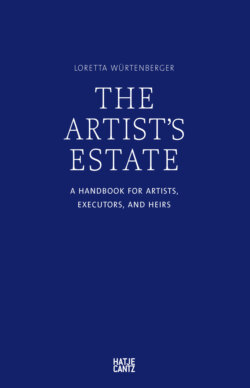Читать книгу The Artist's Estate - Группа авторов - Страница 6
ОглавлениеOn Dealing with Artists’ Estates
By Loretta Würtenberger and Karl von Trott
I. What Is an Artist’s Estate?
1. An Artist’s Estate in the Legal Sense
2. An Artist’s Estate in the Commonly Understood Sense
II. How Should Estate Work Begin?
3. Categorizing the Stock of Artworks
III. In What Forms Can an Artist’s Estate Be Administered?
1. The Imperative of the Artist’s Will
2. Administering an Estate Privately
3. Administering an Estate in an Institutional Form
4. Considerations in Selecting the Type of Estate Structure
5. Aspects of Nonprofit Status
6. Art, Taxes, and Structural Options for Estates
b) United States of America and United Kingdom
(1) Inheritance-Related Laws in the Anglo-American Legal Sphere
(3) Foundations and Artist-Endowed Foundations
IV. Who Should Administer an Artist’s Estate?
b) Third Parties Unrelated to the Family
c) Advisory Bodies and Supervisory Boards
(1) Acquisition of an Estate by a Museum
(2) The Dream of One’s Own Museum
(3) The Artist’s Studio as a Place of Remembrance
d) Other Institutionalized Administrators
e) Specialized Service Providers and Independent Estate Administrators
V. How to Keep an Artist’s Work Alive?
(2) Internal and External Custody of the Archive
(1) The Historical Development of Catalogues Raisonnés
(2) Standards, Methods, and Costs
(3) Catalogues Raisonnés Compiled during the Artist’s Lifetime
d) The Artist’s Estate as a Stimulus for Academic Research
2. Active Collaboration with Museums
3. Entering the Art Market: Branding and the Marketplace
a) Forming Active Relationships with Galleries
c) Participation in the Secondary Art Market
VI. Should an Artist’s Estate Live Forever? Investments, Returns, and the Future
3. Source of Income for Artist’s Estate
(1) Reproduction and Distribution Rights
